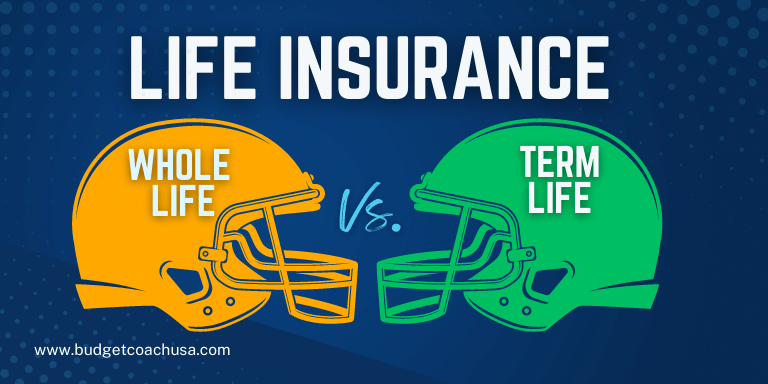Introduction
When it comes to planning for the future and protecting your loved ones, life insurance plays a crucial role. However, with so many options available, it can be overwhelming to determine which type of policy is best suited for your needs. Two popular choices that often arise in this decision-making process are whole life insurance and term life insurance. While both offer a death benefit, they have very different opportunity costs. In this article, we will compare the differences between whole life and term life insurance policies.
Whole Life Insurance & Term Life Insurance Explained
Life insurance is an essential part of protecting your loved ones and with so many options available, the choices can lead to more confusion than answers. We’ve broken down the differences between whole life insurance and term life insurance here and cut through the clutter to offer one obvious answer. There are, broadly speaking two types of life insurance: Whole Life Insurance, which has a variety of names as you’ll see below, and Term Life Insurance.
Whole Life Insurance Explained
Whole Life Insurance (sounds so sophisticated) is a form of permanent life insurance (as long as the premiums are paid) that allows the policyholder to withdraw cash against the policy or surrender it altogether for a payout even prior to death. Proponents will point out that cash-value life insurance is best because not only does it include a death benefit in case you die, but a portion of your premium is recoverable should you want to cash it out prior to death. Before we go any further here is a list of whole life insurance policy variations and the various names that agents and companies like to sell them under. The names are different but they are all a variation of whole life insurance meaning they offer a cash value if surrendered prior to death.
Indexed whole life insurance
Permanent whole life insurance
Universal life insurance both guaranteed and non-guaranteed.
Guaranteed issue whole life insurance
Limited payment whole life insurance
Joint life insurance
Modified whole life insurance
Reduced paid-up whole life insurance
Simplified issue whole life insurance
Single-premium whole life insurance
Variable whole life insurance
Confused? Think of whole life insurance plans like pizza. There are a ton of different types of pizza: New York style, Chicago style, thin and crispy crust, and thick crust or hand-tossed with endless different topping combinations. But they are all still pizza. The important thing to remember is that whole life insurance plans may go by different names but they all share one thing in common: they combine an investment with a death benefit.
Did you say investment? That sounds good, right? Well, you decide. Take a look at the monthly premium price and “investment” value in the illustration below. This graphic is based on a 35-year-old male (we’ll call him Stewart) in good health being quoted a cash-value life insurance policy.

There it is. With a whole life insurance plan, our 35-year-old male Stewart in good health spent a total of $62,400 over 20 years in monthly premiums for a $250,000 death benefit. That’s a lot of monthly premiums paid. If Stewart wanted to surrender it after 20 years they will give him $72,225 back. (see illustration above)
How does that sound to you? Before you decide let’s take a look at Term Life Insurance costs and coverage and see what the same total investment looks like for Stewart after the same 20 years. Remember, Stewart, spent a staggering $62,400 over 20 years on his premiums to protect his family with $250,000 in the event of his death.
Term Life Insurance Explained
Term life insurance only pays a benefit if you die. At the end of a 20-year term life insurance policy, they don’t give you a single penny if you are still alive. Term life is pretty simple. Let’s take a look at the graphic below and see how a Term Life Insurance Policy is priced. (Spoiler alert. Term life policies are a lot cheaper than cash-value plans.) Let’s look at what the numbers look like if Stewart buys a 20-year term life policy instead of a cash-value policy.

Well, there it is. At the end of 20 years, Stewart was covered for $250,000 for just $13 per month. The total he paid into his premiums over those 20 years was grand total of $3,120. However, he won’t get a penny in the end if he is not deceased. And happily so for Stewart since he is still alive!
Which Type of Life Insurance Should You Choose?
The cash value policy gives Stewart $72,000 back at the end of 20 years, right? Yep, but there is a cost to that opportunity. Stewart had to pay $62,400 for the Whole Life Policy over 20 years vs just $3,120 for the premiums for the Term Life Policy. Let’s look at the numbers compared before we draw a final conclusion for the best life insurance option.
Stewart’s Whole Life policy is going to cost him $260 per month and last until he dies. The Term Life Policy is just $13 per month and ends at 20 years. What if Stewart used the difference in monthly premiums between the plans and invested the difference? Let’s compare what it looks like for Stewart to buy the cash-value policy for $260 per month compared to buying the Term Life policy for $13 and adding an additional $247 per month (the premium difference between the policies) to a 401K retirement plan to make things even. Either way, Stewart is investing $260 per month.

Whole Life Insurance Vs. Term Life Insurance – A Comparison
Ouch! That cash-value plan that sounded so sophisticated bit you in the rear end to the tune of an additional $141,587 that you could have had in your pocket after 20 years. Good thing we didn’t run the calculations for 40 years because that would have been a loss to you (and another Caribbean beach house for your insurance salesman) of $1,940,064. Yeah, you read that right. That is what compound interest does and your insurance salesperson knows it. And it is what they are trying to sell you whole life insurance vs term life insurance.
Comparison Questions & Answers
What if I Need 30 Years of Coverage instead of 20?
We hate to say it, actually, we like to say it. If you need 30 years of coverage instead of 20 the difference only grows. That means another beach house for your insurance salesperson and a whole lot of nothing for you! That is why some people call it Whole Life. There is a whole lot of profit for the salesperson and a whole lot of nothing for you.
I See Your Point, But What Happens if I Die After 23 Years? My 20-Year Term Policy Is Expired.
Well, for starters you have $213,812 to provide to your family if you invest the difference as opposed to the whole-life plan you are still paying for at $260 per month. If by the time our 35-year-old male Stewart is 58, he still isn’t financially solvent, he can buy a term life insurance policy for the $37,000 difference for about $20 a month. In fact, his employer is probably already carrying that much or more on his behalf as a benefit anyway.
The Whole Life Policy is Permanent. What is the Maximum Length of Term Life Policy?
Most life insurance companies will offer plans for up to 30 years. So if you start your family around 25, you be 55 by the time your 30-year policy expires.
Remember, when you invest the monthly premium difference between whole life insurance and term life insurance in a qualified retirement plan you will be building value in your own retirement account. Using our example of $247 per month saved (term life vs. cash-value) invested, after 30 years you would have in the neighborhood of $692,000 of retirement savings as protection for your family. We are using an average market return of 11% for this calculation.
Who Should Have Life Insurance?
Anyone who has a dependent to protect. If you are married without kids and your spouse would count on your income to survive if you were deceased, then you need life insurance. If you have children who are dependent on you, you need life insurance. Think of it this way. If you were to pass away is anyone else who depends on you going to be able to provide for themselves and maintain their lifestyle after you are gone? If they cannot, you need life insurance to protect them.
How Much Life Insurance Do I Need?
If you do have dependents it is recommended that you carry 8-10 times your annual income in life insurance to protect your children and spouse. If you make $80,000 per year that your family is dependent on, you should consider carrying between $640,000 and $800,000 in term-life coverage.
Final Thoughts
If you hold a whole life policy now you would be money ahead to stop the bleeding now and switch to a term life policy assuming you will invest the difference in the premiums into your qualified retirement plan. It is your choice. However, never, never, never cancel any life insurance policy until a new one is in place. Did you hear that? Never cancel anything until a new policy is in place.
Life has a lot of twists and turns and the longer you go the more you realize just how many people are after your money. While life insurance and the salespeople who peddle it are no different. Remember, they call it Whole Life because the salesperson gets a whole lot of commission and you get a whole lot less than if you had kept your life insurance and investment strategies separate.
These are the opinions of Budget Coach USA. The reader should complete their own due diligence and decide what is most important to them when selecting a life insurance plan to protect their dependents.


